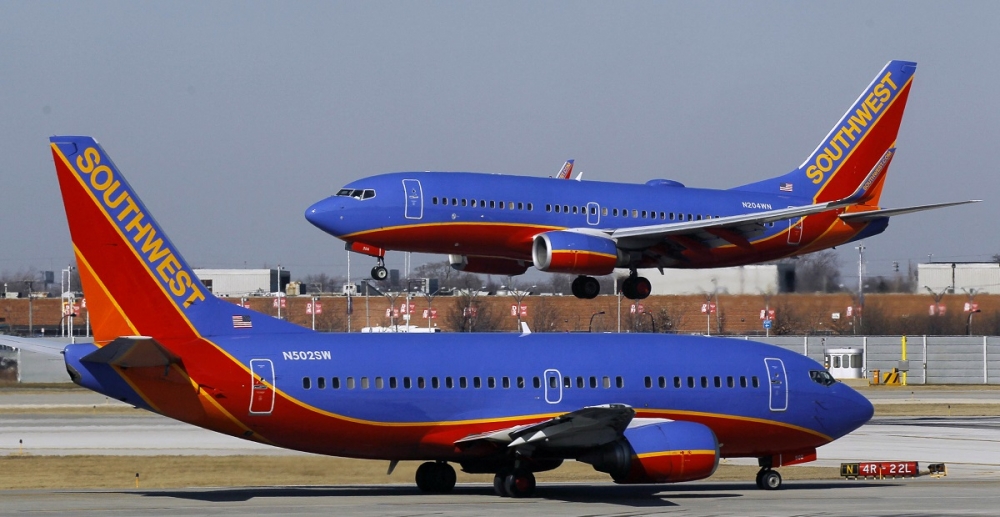Don’t look now, but airline competition is heating up south of the U.S. border. The airline stirring the pot is Southwest Airlines. With 125 million intra US passengers, the country’s largest domestic airline has plans to become a significant international player.
Admittedly, international penetration remains modest at this moment concedes John Kirby, Southwest’s senior director of international business management. But by this time next year, Kirby projects a full one-sixth of the airline’s growth will be in the international arena.
Darryl Jenkins has seen this move coming for a decade and a half now. As early as 2000 the president of the American Aviation Institute says, “It was pretty obvious that they were running out of suitable domestic markets.”
Now, the carrier flies from ten US cities down to the Caribbean, Mexico and Central America, in all with 30 international departures daily. Modest numbers indeed, until you realize that Southwest has identified some 50 destinations in the Americas that it can fly to on what it calls a near international basis. That means as far as the range of its 737-700s and 737-800s will carry them.
Mike Boyd, president of the Boyd Group, an aviation consultancy, says the expansion presently takes in “very near range South America and a lot of Central America” and the Caribbean. Southbound, “that’s all they can do” because of the range of their 737s. Southwest is an all 737 airline and by far the largest operator of the aircraft.
Range capabilities won’t be as much of a problem when Southwest takes delivery of its more fuel-efficient 737 MAX aircraft later on in the decade. Fuel efficiency equates with longer range. If it chooses, Southwest could push deeper into Latin America than the near-northern rim of South America and virtually the whole of Central America.
Southwest had identified three US cities that will see most of the international action: Baltimore, Fort Lauderdale, and Houston.
If you live in, or connect over, Baltimore-Washington International Thurgood Marshall, Fort Lauderdale-Hollywood International or Houston Hobby airports the array of international flight opportunities should grow significantly over the next few years.
Baltimore is where low-fare AirTran cut its international teeth before it merged with Southwest. With the merger, AirTran brought its fleet of internationally-equipped 737-700s, as well as its international expertise. Both have proven invaluable, as Southwest has cautiously tested the temperature of the international waters.
Fort Lauderdale is already the Latin launch pad for a pair of low-fare competitors, JetBlue and Spirit. It’s also close to American Airlines’ formidable Latin American hub at Miami International Airport. This begs the questions: can three low-fare carriers compete successfully out of one airport? Can Southwest’s international focus on Fort Lauderdale lead to too many seats, and, at least temporarily, lower airfares? “That’s an interesting question,” says Jenkins. It could well depend on “how aggressive and expansive Southwest really is.”
John Kirby believes the south Florida market is robust enough to handle the competition, and that his airline brings with it the added advantage automatic brand loyalty.
Then there’s Houston Hobby, already the site of already formidable domestic operations for Southwest. By the fourth quarter of 2015, about a year from now, plans are to open a five-gate international terminal at the close-to-downtown airport. Southwest will have preferential use of four of those gates. It anticipates eventually serving 20 to 30 ‘near-international’ destinations out of Houston.
The move has riveted the attention of Bush Houston Intercontinental-hubbed United Airlines, which raised objections to Hobby’s new international facility. “They realize that we’re coming,” says Kirby. “They’ve seen the international terminal going up. We fully expect them to compete with us. When there’s competition, the consumer wins.”
Chicago Midway Airport is a case-in-point. When Southwest launched nonstop Chicago – Cancun, Mexico service, that market “grew by almost 50 percent,” asserts Kirby. When Chicago – Punta Cana, Dominican Republic flights started, he says the size of the market soared by some “250 percent.” The reason: service and “slight fare stimulation.”
Without divulging the specific routes Southwest plans fly in the future, Kirby says the carrier is looking closely at a newly-attractive Colombia, a country rich with tourist and business potential that’s finally in the process of shedding itself of drug cartel influence. Located on the 737-700 reachable north rim of South America, Bogota is a big draw. Panama is a place on the grow too. Southwest already flies nonstop from Baltimore-Washington to San Juan, Costa Rica, a hot business and eco-tourism spot in Central America.
Again, in terms of numbers the present international presence is modest, at best. International operations consist of 10 US international gateways, 25 international routes (with two more set for June 2015), and eight international destinations. The seaside resort of Puerto Vallarta, Mexico becomes the ninth next year.
Currently, Southwest flies from the US to Aruba; Cancun, Mexico; Montego Bay, Jamaica; San Jose, Costa Rica; Los Cabos, Mexico; Mexico City, Punta Cana Dominican Republic and Nassau in the Bahamas. Although it flies to San Juan, Puerto Rico too, that’s a US territory. It’s not strictly counted in the international ranks.
Although Southwest’s sight is set south just now, the prospects of trans border flights to Canada are certainly not off its radar screen.
However don’t look for Southwest Airlines’ Latin strategy to suddenly result in dozens of new routes to dozens of new places. It doesn’t happen that way anymore in the airline industry, an industry that has learned the hard way that too-rapid, break neck expansion can kill an airline. Today, growth is far more measured.
“Southwest’s strategic thinking is very long term,” says American Aviation Institutes’ Darryl Jenkins. They’ve had international expansion on their mind for some time.”
























